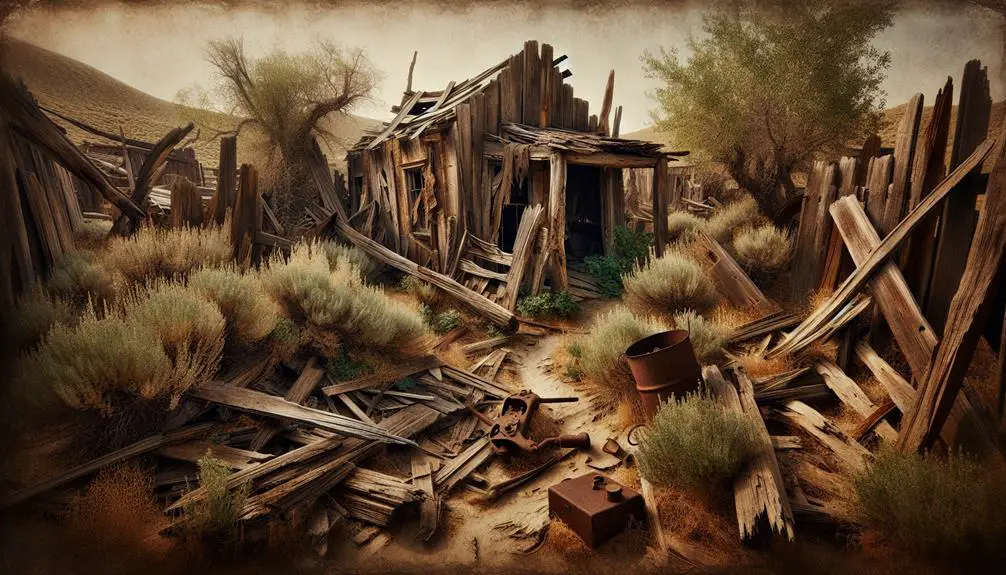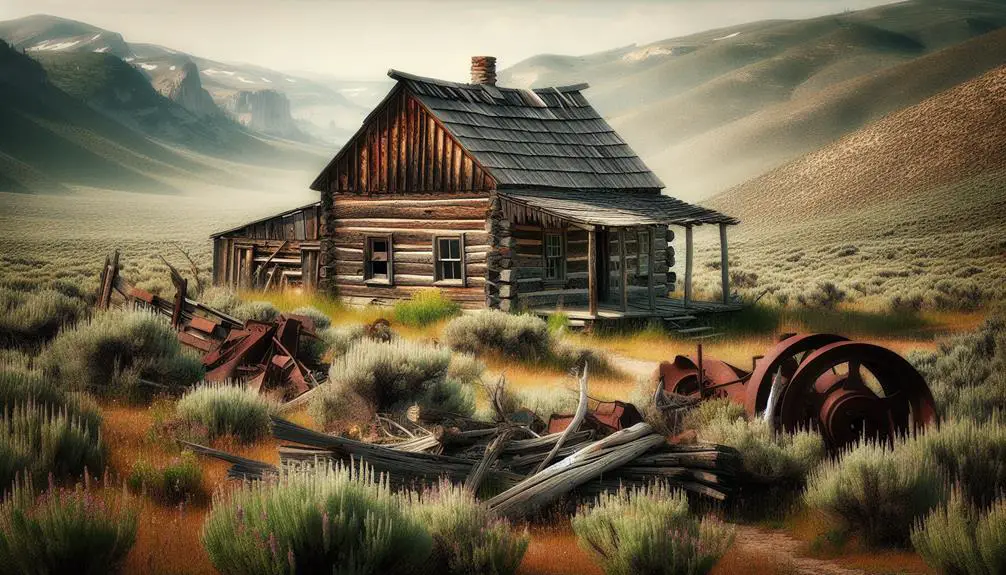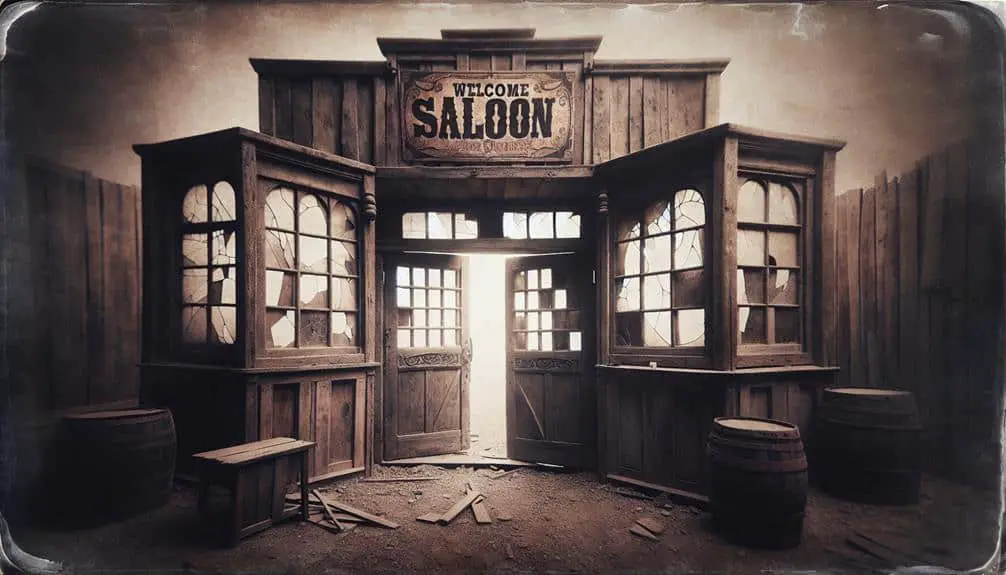Explore the weathered structures and remnants of a bygone era. Old West homesteads stand today, showcasing settlers' resilient spirit and the challenges they overcame. These historical sites reveal frontier architecture like log cabins and sod houses. Factors like economic struggles and environmental hardships led to abandonment. Preservation efforts aim to maintain authenticity and cultural significance. Ghost towns offer unique tourist attractions, drawing visitors seeking history frozen in time. These homesteads shape perceptions of the past and contribute to local economic development. Discover more about their enduring legacy and the efforts to honor their history.
Key Points
- Restored homesteads serve as historical sites.
- Preservation efforts maintain cultural authenticity.
- Homesteads offer insight into pioneer life.
- Tourist attractions in ghost towns attract visitors.
- Homesteads contribute to local economy through tourism.
Historical Background of Old West Homesteads
The historical background of Old West homesteads reveals a unique blend of rugged determination and pioneering spirit that shaped the landscape of the American frontier. Settler life in these homesteads was characterized by self-sufficiency, hard work, and a deep connection to the land. The settlers built their homes using frontier architecture, which often included log cabins, sod houses, or simple wooden structures that could withstand the harsh conditions of the frontier.
These homesteads were more than just dwellings; they were symbols of resilience and independence. The settlers faced numerous challenges, from harsh weather to conflicts with indigenous populations, yet they persevered, carving out a living in the vast wilderness of the West. Their homes were a reflection of their ingenuity and resourcefulness, embodying the values of freedom and self-reliance that defined the American frontier.
Exploring the historical background of Old West homesteads offers a glimpse into a bygone era, where the pioneering spirit of settlers shaped the landscape and laid the foundation for the development of the American West.
Factors Contributing to Abandonment
Factors contributing to the abandonment of Old West homesteads can be attributed to a combination of economic challenges and environmental hardships faced by the settlers. The economic decline, marked by fluctuations in agricultural markets and limited access to resources, played a significant role in the decision to leave these homesteads behind. Settlers often found it difficult to sustain their livelihoods due to these economic pressures, leading to the gradual desertion of once-thriving communities.
Moreover, environmental changes such as prolonged droughts, unpredictable weather patterns, and soil degradation further exacerbated the challenges faced by homesteaders. These environmental factors made it increasingly difficult to cultivate crops, raise livestock, and maintain essential infrastructure, pushing many settlers to abandon their homes in search of more hospitable living conditions.
Preservation Efforts and Challenges
Exploring the preservation efforts and challenges surrounding Old West homesteads reveals a complex landscape of historical restoration and conservation initiatives. Restoration projects play an essential role in maintaining the authenticity and cultural significance of these sites. Many organizations and individuals are actively involved in restoring old buildings, artifacts, and landscapes to their former glory. These projects aim to not only preserve the physical structures but also the stories and way of life that these homesteads represent.
Community involvement is a key factor in the success of preservation efforts. Local residents, historians, and enthusiasts often come together to raise funds, find their way, volunteer their time, and advocate for the protection of these historical sites. The sense of community pride and shared history drives these preservation initiatives forward.
However, preservation efforts also come with their fair share of challenges. Securing funding for restoration projects, finding their way through legal hurdles, and balancing the need for modern amenities while preserving historical integrity are common obstacles faced in the conservation of Old West homesteads. Overcoming these challenges requires strategic planning, collaboration, and a deep commitment to honoring the past while embracing the future.
Tourist Attractions in Ghost Towns
Exploring through the remnants of Old West homesteads often leads visitors to discover a unique array of tourist attractions in ghost towns. Ghost towns, with their abandoned buildings and dusty streets, offer more than just a glimpse into the past. They've become popular destinations for those seeking paranormal experiences and unique photography opportunities. Many visitors are drawn to the mysterious aura that surrounds these deserted places, hoping to capture a piece of history frozen in time.
Beyond their eerie charm, ghost towns hold significant cultural value. They serve as reminders of the hardships faced by early settlers and the fleeting nature of boomtowns. By preserving these sites as tourist attractions, communities can tap into their economic potential, driving local businesses and fostering a sense of pride in their heritage. The influx of tourists seeking out these abandoned relics can contribute to the revitalization of once-forgotten towns, breathing new life into forgotten corners of the Old West.
Impact of Old West Homesteads Today
Old West homesteads continue to exert a lasting influence on contemporary society, shaping perceptions of the past and preserving a tangible connection to bygone eras. These historic sites offer renovation opportunities that not only breathe new life into old structures but also provide a platform for community engagement. Through initiatives aimed at restoring these homesteads, individuals can actively participate in preserving the cultural heritage embedded within these spaces.
Moreover, the presence of Old West homesteads contributes notably to economic development in regions where these sites are located. Tourists are drawn to these locations, injecting revenue into local businesses and boosting job opportunities within the community. This economic influx not only benefits the immediate vicinity but also has a ripple effect on the surrounding areas.
Frequently Asked Questions
Are There Any Famous Legends or Ghost Stories Associated With Old West Homesteads?
Explore the eerie folklore surrounding old west homesteads. Haunting tales and supernatural encounters weave through the abandoned structures. Ghostly whispers and spooky happenings linger in the air, inviting you to uncover the mysteries within.
What Kind of Wildlife Can Be Found in and Around Abandoned Homesteads?
You'll find a vibrant ecosystem teeming with diverse wildlife habitats around abandoned homesteads. Preservation efforts are essential to mitigate the ecological impact. Conservation initiatives aim to protect these areas, fostering a harmonious coexistence between nature and history.
How Do Modern Day Communities Near Ghost Towns View Their Historical Significance?
You perceive the historical significance of ghost towns differently. Community perspectives vary, shaping preservation efforts. Some cherish the past, advocating for restoration. Others prioritize modern development, potentially neglecting these remnants of bygone eras.
Are There Any Unique Architectural Features or Designs Commonly Found in Old West Homesteads?
When exploring old west homesteads, you'll notice distinctive architectural features like adobe walls, covered porches, and pitched roofs. These unique designs reflect the practicality and resilience of those who once called these places home.
Are There Any Notable Events or Celebrations Held in Ghost Towns to Commemorate Their History?
Notable events and celebrations in ghost towns include historical reenactments and community events that commemorate their past. Preservation efforts help maintain these sites, offering tourism opportunities for those interested in experiencing a piece of history firsthand.



